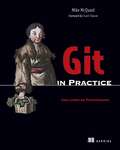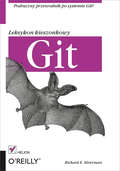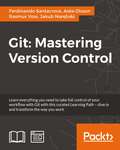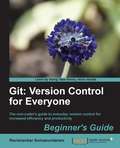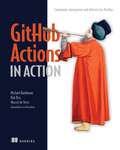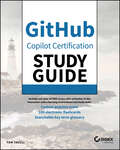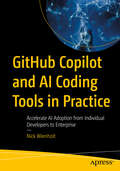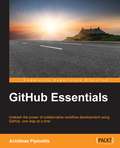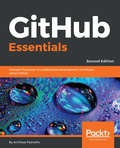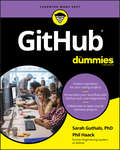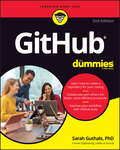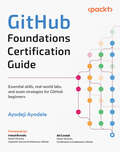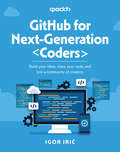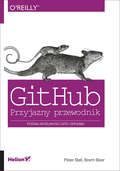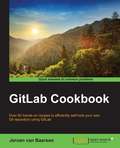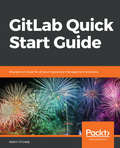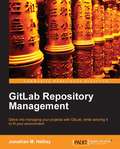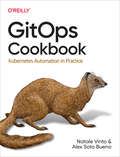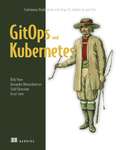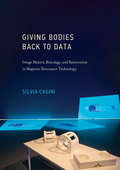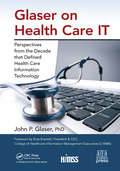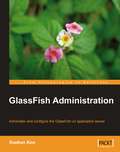- Table View
- List View
Git in Practice: Includes 66 Techniques
by Mike McQuaidSummaryGit in Practice is a collection of 66 tested techniques that will optimize the way you and your team manage your development projects. The book begins with a brief reminder of the core version control concepts you need when using Git and moves on to the high-value features you may not have explored yet. Then, you'll dig into cookbook-style techniques like history visualization, advanced branching and rewriting history each presented in a problem-solution-discussion format. Finally you'll work out how to use Git to its full potential through configuration, team workflows, submodules and using GitHub pull requests effectively.Purchase of the print book includes a free eBook in PDF, Kindle, and ePub formats from Manning Publications. About the TechnologyGit is a source control system, but it's a lot more than just that. For teams working in today's agile, continuous delivery environments, Git is a strategic advantage. Built with a decentralized structure that's perfect for a distributed team, Git manages branching, committing, complex merges, and task switching with minimal ceremony so you can concentrate on your code. About the BookGit in Practice is a collection of battle-tested techniques designed to optimize the way you and your team manage development projects. After a brief overview of Git's core features, this practical guide moves quickly to high-value topics like history visualization, advanced branching and rewriting, optimized configuration, team workflows, submodules, and how to use GitHub pull requests. Written in an easy-to-follow Problem/Solution/Discussion format with numerous diagrams and examples, it skips the theory and gets right to the nitty-gritty tasks that will transform the way you work.Written for developers familiar with version control and ready for the good stuff in Git.What's InsideTeam interaction strategies and techniquesReplacing bad habits with good practicesJuggling complex configurationsRewriting history and disaster recovery About the AuthorMike McQuaid is a software engineer at GitHub. He's contributed to Qt and the Linux kernel, and he maintains the Git-based Homebrew project.Table of ContentsPART 1 INTRODUCTION TO GITLocal GitRemote GitPART 2 GIT ESSENTIALSFilesystem interactionsHistory visualizationAdvanced branchingRewriting history and disaster recoveryPART 3 ADVANCED GITPersonalizing GitVendoring dependencies as submodulesWorking with SubversionGitHub pull requestsHosting a repositoryPART 4 GIT BEST PRACTICESCreating a clean historyMerging vs. rebasingRecommended team workflows
Git. Leksykon kieszonkowy
by Richard E. Silverman"Podr?czny przewodnik po Git!Jeszcze do niedawna w?ród systemów kontroli wersj? fotel lidera zajmowa? SVN. Jednak ta sytuacja w ostatnich latach ulega diametralnej zmianie. Rynek systemów kontroli wersji opanowa?y systemy rozproszone, z Gitem na czele. Czemu zdoby?y tak? popularno??? Dzi?ki zastosowaniu Gita ka?dy programista dysponuje swoj? lokaln?, kompletn? kopi? ca?ego repozytorium. Pozwala to na b?yskawiczne wykonywanie typowych zada? i korzystanie z mo?liwo?ci kontroli wersji bez wp?ywu na repozytoria innych osób. A? do momentu, gdy stwierdzisz, ?e chcesz podzieli? si? efektami pracy z innymi.Brzmi interesuj?co? Je?li chcia?by? zg??bi? system Git, trafi?e? na doskona?? ksi??k?. Dzi?ki jej niewielkim rozmiarom mo?esz mie? j? zawsze przy sobie. Zmiana SVN na Git oprócz poznania nowych poj?? wymaga zmiany sposobu my?lenia. Ten leksykon pozwoli Ci w ka?dej chwili sprawdzi?, jak stworzy? nowe repozytorium czy ga??? oraz jak wprowadzi? zmiany i przes?a? je na centralny serwer. Ponadto dowiesz si?, jak ?ledzi? zdalne repozytoria, przegl?da? histori? zmian i scala? wersje. To doskona?a lektura dla wszystkich osób chc?cych b?yskawicznie pozna? mo?liwo?ci Gita i zacz?? stosowa? go w codziennej pracy.Dzi?ki tej ksi??ce: poznasz filozofi? pracy z Gitem stworzysz repozytorium i zaczniesz z niego korzysta? nauczysz si? pracowa? z ga??ziami kodu biegle opanujesz system GitPoznaj rozproszony system kontroli wersji!"
Git: Mastering Version Control
by Aske Olsson Rasmus Voss Ferdinando Santacroce Jakub NarebskiLearn everything you need to take full control of your workflow with Git with this curated Learning Path - dive in and transform the way you work About This Book * Master all the basic concepts of Git to protect your code and make it easier to evolve * Filled with practical recipes that will teach you how to use the most advanced features of the Git system * Harness the full power of the Git version control system to customize Git behavior, manipulate history, integrate external tools, and explore platform shortcuts Who This Book Is For This learning path is for software developers who want to become proficient at using the Git version control system. A basic understanding of any version control system would be beneficial. What You Will Learn * Transport your work to a remote repository in a centralized manner * Experiment with your code without affecting functional code files * Explore some tools used to migrate to Git from other versioning systems without losing your development history * Understand the Git data model and how you can navigate the database with simple commands * Debug with Git and use various techniques to find faulty commits * Customize Git behavior system-wide, on a per-user, per-repository, and per-file basis * Master administering and setting up Git repositories, configuring access, finding and recovering from repository errors, and performing repository maintenance * Chose a workflow and configure/set up support for the chosen workflow In Detail Git is one of the most popular types of Distributed Version Control System. Since its inception, it has attracted skilled developers due to its robust, powerful, and reliable features. Like most powerful tools, Git can be hard to approach for the newcomers. However, this learning path will help you overcome this fear and become adept at all the basic and advanced tasks in Git. This course starts with an introduction to version control systems before you delve deeply into the essentials of Git. This serves as a primer for the topics to follow such as branching and merging, creating and managing a GitHub personal repository, and fork and pull requests. You'll also learn how to migrate from SVN using Git tools or TortoiseGit and migrate from other VCSs, concluding with a collection of resources, links, and appendices. As you progress on to the next module, you will learn how you can automate the usual Git processes by utilizing the hook system built into Git. It also covers advanced repository management, including different options to rewrite the history of a Git repository before you discover how you can work offline with Git, how to track what is going on behind the scenes, and how to use the stash for different purposes. Moving forward, you will gain deeper insights into Git's architecture, its underlying concepts, behavior, and best practices. It gives a quick implementation example of using Git for a collaborative development of a sample project to establish the foundation knowledge of Git operational tasks and concepts. By exploring advanced Git practices, you will attain a deeper understanding of Git's behavior, allowing you to customize and extend existing recipes and write your own. This Learning Path is a blend of content, all packaged up keeping your journey in mind. It includes content from the following Packt products: * Git Essentials, Ferdinando Santacroce * Git Version Control Cookbook, Aske Olsson and Rasmus Voss * Mastering Git, Jakub Narebski Style and approach Its step-by-step approach with useful information makes this course the ultimate guide to understanding and mastering Git. This course will show the road to mastery example by example, while also explaining the mental model of Git.
Git: Version Control for Everyone
by Ravishankar SomasundaramThe book follows a Blended Learning Approach (Learning through multiple modes: Readers learn theory to understand the concept and reinforce it by practically doing it). The new concepts are introduced using examples of common day to day activities for quick realization spread across topics. For the computer literate who want to leverage the advantage of maintaining multiple versions of files/folders to go back and forth in time with respect to the files content. For developers, administrators, analysts, architects and any others who want to perform a simultaneous, collaborative or work in parallel on the same set of files.
GitHub Actions in Action: Continuous integration and delivery for DevOps
by Michael KaufmannAutomate your build, test, and deploy pipelines using GitHub Actions!Continuous delivery (CI/CD) pipelines help you automate the software development process and maximize your team&’s efficiency. GitHub Actions in Action teaches you how to build, test, and deploy pipelines in GitHub Actions through hands-on labs and projects. In GitHub Actions in Action you will learn how to: • Create and share GitHub Actions workflows • Automate CI/CD workloads and other GitHub tasks • Secure release pipelines with secrets, variables, and environments • Support compliance frameworks • Create safe and scalable self-hosted runners Written by three Microsoft MVPs and tech reviewed by a Staff DevOps Architect from GitHub, this book delivers the hardworking skills and advice you&’ll need to be successful on the job. DevOps engineers will love GitHub Actions in Action&’s coverage of reliable methods for Infrastructure-as-Code and automating cloud environments. You&’ll follow an extended example application for selling tickets, taking it all the way from initial build to cloud deployment. Foreword by Scott Hanselman. About the technology Believe it or not, CI/CD can be simple! With GitHub Actions, you can automate your entire dev process using just the tools built into GitHub—no external frameworks or complex integrations required. GitHub Actions is secure, reliable, and best of all, easy. This book will get you started. About the book GitHub Actions in Action teaches you how to build automated delivery pipelines in GitHub. You&’ll start with simple examples that demonstrate workflow and action basics, and then you&’ll dive into platform architecture, security, and workflow runtime details. As you go, you&’ll build a full CI/CD pipeline, optimizing for compliance, performance, and costs. You&’ll even create shareable actions for the GitHub marketplace. What's inside • Create and share GitHub Actions workflows • Automate testing and other GitHub tasks • Secure release pipelines with secrets, variables, and environments About the reader For developers and DevOps engineers comfortable with GitHub. About the author Michael Kaufmann is a Microsoft Regional Director and MVP. Rob Bos is an Azure and GitHub Trainer, a Microsoft MVP, a GitHub Star, and a LinkedIn Learning Instructor. Marcel de Vries is a CTO of Xebia Microsoft Services, Microsoft Regional Director, and MVP. The technical editor on this book was James Michael Gousset. Table of Contents Part 1 1 Introduction to GitHub Actions 2 Hands-on: My first Actions workflow 3 Workflows 4 GitHub Actions Part 2 5 Runners 6 Self-hosted runners 7 Managing your self-hosted runners Part 3 8 Continuous integration 9 Continuous delivery 10 Security 11 Compliance 12 Improving workflow performance and costs
GitHub Copilot Certification Study Guide (Sybex Study Guide)
by Tom TaulliThe fastest, most effective way to prepare for the GitHub Copilot certification exam and hone your skills with the popular AI-powered programming tool In the GitHub Copilot Certification Study Guide, tech entrepreneur and Pluralsight trainer, Tom Taulli, delivers a concise and accurate walkthrough of the AI-powered programming tool. Perfect for everyone preparing to take the new GitHub Copilot Certification exam, as well as programmers who regularly use the tool in their day-to-day work, this Study Guide helps you optimize your software development workflows, understand the structure of the test, and learn the material covered by it. This book explains every topic covered by the GitHub Copilot Certification exam, including: Responsible AI GitHub Copilot plans and features The inner workings of GitHub Copilot and how it handles data Prompt crafting and prompt engineering Developer use cases Testing workflows with GitHub Copilot Privacy fundamentals and context exclusions From step-by-step tutorials of the GitHub Copilot installation process to proven exam-taking techniques from the experts at Sybex, the GitHub Copilot Certification Guide explores everything you need to understand to succeed on the test and improve your on-the-job coding performance. It offers: Job-ready strategies and techniques for avoiding common generative AI-enhanced programming pitfalls and making use of its many benefits Up-to-date descriptions of the most useful features and functions of GitHub Copilot, including Copilot Edits Complimentary access to a practice Assessment Test, a Practice Exam, 100 digital flashcards, and a glossary of key terms on the Sybex online learning environment Generative AI tools, like GitHub Copilot, have transformed the software engineering and programming landscapes. If you're preparing for the certification exam, or you wish to expand your AI coding skillset, grab a copy of the GitHub Copilot Certification Study Guide today.
GitHub Copilot and AI Coding Tools in Practice: Accelerate AI Adoption from Individual Developers to Enterprise
by Nick WienholtLearn the current state of generative AI coding tools like GitHub Copilot, what the underlying models mean, and how to use them across the full development life-cycle. Look ahead to the near future of AI-generated software and understand how software developers can stay relevant in the industry. Many companies have predicted that human coders will soon be redundant due to AI-generated code, but there is a big gap between the expectations and what is actually happening on the ground. A closer look at the current state of the tools and research in this area will offer realism and guidance to developers worried regarding redundancy. Close the gap between hype and practical applications by receiving context and clear technical information on usage, understanding, and deployment of these tools. What You Will Learn: How to use coding and software AI tools How software AI tools work How software AI tools fit in an industry context How to use AI tools across the SDLC – it's more than just faster coding Who This Book is For All software industry participants interested in mastering AI-generated code.
GitHub Essentials
by Achilleas PipinellisUnleash the power of collaborative development workflow using GitHub, one step at a time About This Book * Effectively use GitHub by learning its key features that leverage the power of Git and make collaboration on code easy to work with. * Be more productive on the development workflow of your projects using the valuable toolset that GitHub provides. * Explore the world of GitHub by following simple step-by-step real world scenarios accompanied by helpful, explanatory screenshots Who This Book Is For Intended for experienced or novice developers with a basic knowledge of Git. If you ever wanted to learn how big projects like Twitter, Google or even GitHub collaborate on code then this book is for you What You Will Learn * Create and upload repositories to your account * Create organizations and manage teams with different access levels on repositories * Use effectively the issue tracker and add context to issues with labels and milestones * Schedule and release versions of your software * Work effectively with a team and collaborate on code * Create, access, and personalize your user account and profile settings * Build a community around your project using the sophisticated tools GitHub provides * Build easy to deploy, free of charge static websites for your projects In Detail Whether you are an experienced developer or a novice, learning to work with Version Control Systems is a must in the software development world. Git is the most popular tool for that purpose and GitHub was built around it leveraging its powers by bringing it to the web. Starting with the basics of creating a repository you will then learn how to manage the issue tracker, the place where discussion about your project takes place. Continuing our journey we will explore how to use the wiki and write rich documentation that will accompany your project. Organization and team management will be the next stop and then onto the feature that made GitHub so well known, Pull Requests. Next we focus on creating simple web pages hosted on GitHub and lastly we explore the settings that are configurable for a user and a repository. Style and approach A step-by-step guide with real world scenarios accompanied by helpful images. Each topic is thoroughly explained with hands-on-examples and code where needed. At the end of each chapter there is a Tips and tricks section presenting hidden or overlooked features of GitHub.
GitHub Essentials: Unleash the power of collaborative development workflows using GitHub, 2nd Edition
by Achilleas Pipinellis Umesh R SharmaThis book will teach you what you need to know to start using GitHub effectively for collaborating and working on your software projects.Key FeaturesEffectively use GitHub by learning its key features to leverage the power of Git and make collaboration on code easy to work with.Be more productive on the development workflow of your projects using the valuable toolset that GitHub provides.Explore the world of GitHub by following simple, step-by-step, real-world scenarios accompanied by helpful, explanatory screenshots.Book DescriptionWhether you are an experienced developer or a novice, learning to work with Version Control Systems is a must in the software development world. Git is the most popular tool for that purpose, and GitHub was built around it, leveraging its powers by bringing it to the web.Starting with the basics of creating a repository, you will then learn how to manage the issue tracker, the place where discussions about your project take place. Continuing our journey, we will explore how to use the wiki and write rich documentation that will accompany your project. You will also master organization/team management and some of the features that made GitHub so well known, including pull requests. Next, we will focus on creating simple web pages hosted on GitHub and lastly, we will explore the settings that are configurable for a user and a repository.What you will learnCreate and upload repositories to your accountCreate organizations and manage teams with different access levels on repositoriesUse the issue tracker effectively and add context to issues with labels and milestonesCreate, access, and personalize your user account and profile settingsBuild a community around your project using the sophisticated tools GitHub providesCreate GitHub pages and understand web analyticsWho this book is forThis book is for experienced or novice developers with a basic knowledge of Git. If you ever wanted to learn how big projects such as Twitter, Google, or even GitHub collaborate on code, then this book is for you.
GitHub For Dummies
by Phil Haack GuthalsCode collaboratively with GitHub Once you’ve learned the basics of coding the next step is to start sharing your expertise, learning from other coding pros, or working as a collaborative member of development teams. GitHub is the go-to community for facilitating coding collaboration, and GitHub For Dummies is the next step on your journey as a developer. Written by a GitHub engineer, this book is packed with insight on how GitHub works and how you can use it to become a more effective, efficient, and valuable member of any collaborative programming team. Store and share your work online with GitHub Collaborate with others on your team or across the international coding community Embrace open-source values and processes Establish yourself as a valuable member of the GitHub community From setting up GitHub on your desktop and launching your first project to cloning repositories, finding useful apps on the marketplace, and improving workflow, GitHub For Dummies covers the essentials the novice programmer needs to enhance collaboration and teamwork with this industry-standard tool.
GitHub For Dummies
by Sarah GuthalsGet more out of your coding with GitHub For today’s coders, GitHub is a must. The world’s largest software development platform, GitHub helps developers store, track, and collaborate on software projects. In this easy-to-follow Dummies guide, you’ll find insight into creating repositories, establishing projects, collaborating, incorporating open-source resources, and establishing yourself as a valued member of the GitHub community. With a working knowledge of GitHub, you’ll be a better, more employable programmer. The simple instructions and interactive examples in this book will get you there quickly. Get the instructions you need for using GitHub to collaborate on software projects Become more attractive to employers with knowledge and experience in the largest development platform Set up GitHub Desktop, create a repository, and launch your first project Use GitHub Skills courses to learn new tricks, for beginners to prosYou’ve learned how to write a little code—now learn how to share it with GitHub.
GitHub Foundations Certification Guide: Essential skills, real-world labs, and exam strategies for GitHub beginners
by Ayodeji Ayodele"Readers will gain the skills needed to pass the certification and a deeper appreciation of how GitHub can transform the way individuals and teams build software." - Irshad Burtally, Senior Director, Customer Success Architecture, GitHub "Whether you prefer instructor-led training, on-demand videos, or interactive labs, the GitHub Foundations Certification journey meets you where you are - making learning accessible, engaging, and relevant." - Ali Condah, Senior Director, Certification & Enablement, GitHubKey FeaturesBecome an expert in Git and GitHub for modern development Solidify your learning using hands-on guides with real-world projects and self-assessment questionsPrepare for the certification exam with questions, tests, and study tipsPurchase of the print or Kindle book includes a free PDF eBookBook DescriptionProgress from the basics of version control to excelling at collaborative development with the GitHub Foundations Certification Guide, your go-to resource for mastering Git and GitHub. You'll learn how to use Git to accurately track and manage code changes, and discover why GitHub is the leading platform for collaboration, project management, and open-source development. Written by Ayodeji Ayodele, Senior Customer Success Architect at GitHub with expertise in DevOps, Agile coaching, and software engineering, this book provides a structured path to Git/GitHub proficiency. Through hands-on tutorials, projects, and self-assessment questions, you’ll harness the potential of open source, navigate the GitHub platform with ease, employ advanced Git techniques, and gain practical code management skills. The book then explores secure collaboration, automation, and key features of the GitHub Desktop app. You’ll prepare for the certification exam with practice questions, mock exams, and invaluable study tips. By the end of this book, you’ll be ready to take the GitHub Foundations exam and advance your developer career.What you will learnCreate and manage repositories on GitHub confidentlyCollaborate effectively using issues and pull requestsAdopt modern development practices using advanced GitHub featuresEnhance coding speed and quality with GitHub Copilot's AI suggestionsStreamline project management using GitHub ProjectsLeverage GitHub's capabilities to boost your career or grow your businessImplement best practices for GitHub privacy, security, and controlWho this book is forThis book is for software developers and engineers looking to master Git and GitHub for efficient code management, project collaboration, and streamlined workflows. Infrastructure engineers and system administrators will benefit from learning how to manage scripts and track infrastructure changes. Educators and trainers can use this guide to teach software development and prepare students for industry certifications. Aspiring developers and tech professionals will find it a valuable resource for building essential GitHub skills and advancing their software development careers.
GitHub for Next-Generation Coders: Build your ideas, share your code, and join a community of creators
by Igor IrićBuild a powerful portfolio on GitHub that showcases your most impressive coding projects and technical skillsKey FeaturesExplore GitHub's powerful features and make it the central hub for all your coding adventuresLearn how to use GitHub Copilot as your coding sidekick, suggesting lines of code to help you write faster and smarterLearn how to optimize and personalize your GitHub profiles for maximum impact from a community leaderPurchase of the print or Kindle book includes a free PDF eBookBook DescriptionNavigating the world of collaborative software development can be daunting, especially for young coders just starting their programming journey. This book is designed to take you on a coding adventure, transforming you from a curious beginner into a confident GitHub user. The book builds a solid foundation and explains the Git version control system in depth, helping you understand how to track changes, collaborate effectively, and manage your projects with ease. You'll master repositories, the building blocks of your coding projects, and learn branching strategies to experiment and work seamlessly with others. The chapters will teach you about GitHub Actions, guiding you through workflow syntax, exploring environments and secrets management, and providing hands-on exercises to solidify your understanding. You’ll also discover how to craft a compelling GitHub profile that highlights your achievements and discover the exciting world of open-source projects where you can contribute and give back to the community. To get you started with AI, you’ll also learn how to leverage Copilot and ChatGPT together to write faster, cleaner code. By the end of this book, you’ll be well prepared to contribute to real-world projects on GitHub, equipped with the skills to thrive in the world of collaborative software development.What you will learnTravel back in code history and track different versions of your projectsKeep your code blocks neat and tidy within your repository, just like sorting puzzle pieces to create a masterpieceCreate branches to experiment with new ideas or features without messing up your main codeUse Git to share your suggestions and collaborate with other coders to make your code even more amazingAutomate and level up your coding game with GitHub ActionsBuild your coder reputation by contributing to open source projectsWho this book is forThis book is for young, tech-curious individuals eager to find out more about the world of software development. If you are a student motivated to learn GitHub to better understand collaborative coding practices, manage projects effectively, and potentially pursue careers or hobbies in the technology field, then this book is for you.
GitHub. Przyjazny przewodnik: Przyjazny Przewodnik
by Peter Bell Brent BeerPoznaj mo?liwo?ci Gita i GitHuba!Git zrewolucjonizowa? ?wiat systemów kontroli wersji. Koncepcja rozproszonego systemu podbi?a serca programistów i ustanowi?a trendy na kolejna lata. Co powsta?o z po??czenia Gita i serwisu udost?pniaj?cego miejsce oraz narz?dzia dla programistów korzystaj?cych z Gita? To GitHub — najpopularniejsze miejsce w sieci, w którym znajdziesz tysi?ce projektów. GitHub wytycza dzi? ?cie?ki dla platform u?atwiaj?cych prac? z rozproszonymi systemami kontroli wersji.Ta ksi??ka zosta?a w ca?o?ci po?wi?cona w?a?nie GitHubowi. Si?gnij po ni? i przekonaj si?, jakie us?ugi oferuje ten serwis oraz jak wykorzysta? jego potencja? w Twoim projekcie. W trakcie lektury dowiesz si?, jak przegl?da? udost?pniony kod, wspó?pracowa? przy projektach oraz dostarcza? poprawki. Ponadto nauczysz si? zarz?dza? zg?oszonymi przez u?ytkowników problemami w Twoim kodzie oraz opanujesz najlepsze praktyki konfigurowania Twojego repozytorium. Na sam koniec poznasz narz?dzia przeznaczone dla systemów MacOS i Windows, a s?u??ce do wspó?pracy z serwisem GitHub. Ksi??ka ta jest obowi?zkow? lektur? dla wszystkich czytelników chc?cych w pe?ni wykorzysta? potencja? drzemi?cy w tym serwisie. Dowiedz si? jak i dlaczego ludzie u?ywaj? GitHuba do wspó?pracy. Przegl?daj bie??cy stan projektu — najnowsze zmiany, prace do wykonania i histori? poprawek. Twórz i edytuj pliki w GitHubie bez znajomo?ci systemu Git. Sugeruj zmiany w projektach, w których nie masz uprawnie? do bezpo?redniego wprowadzania poprawek. U?ywaj narz?dzi do obs?ugi problemów i zg?osze?, twórz ga??zie w celu definiowania nowych funkcji i wspólnej pracy nad zmianami. Twórz nowe repozytoria GitHuba, z uwzgl?dnieniem praw dost?pu do swojego projektuZaawansowany system kontroli wersji dla ka?dego!
GitLab Cookbook
by Jeroen Van BaarsenThis book is aimed at developers and devops that have a GitLab server running, and want to be sure they use it to its full potential. This book will also be useful for people looking for a great Git platform, and learn how to set it up successfully. Some system administrating experience on a UNIX-based system would be useful, but is not required.
GitLab Quick Start Guide: Migrate to GitLab for all your repository management solutions
by Adam O'GradyPort projects over from GitHub and convert SVN projects to GitLab hosted git projectsKey FeaturesEffective guide for GitLab migration from GitHub and SVNLearn to implement DevOps with GitLab 11Manage projects with issue boards and time trackingBook DescriptionGitlab is an open source repository management and version control toolkit with an enterprise offering. This book is the ideal guide to GitLab as a version control system (VCS), issue management tool, and a continuous integration platform.The book starts with an introduction to GitLab, a walkthrough of its features, and explores concepts such as version control systems, continuous integration, and continuous deployment. It then takes you through the process of downloading and installing a local copy of the on-premise version of GitLab in Ubuntu and/or CentOS.You will look at some common workflows associated with GitLab workflow and learn about project management in GitLab. You will see tools and techniques for migrating your code base from various version control systems such as GitHub and SVN to GitLab.By the end of the book, you will be using Gitlab for repository management, and be able to migrate projects from other VCSs to GitLab.What you will learnSet up CI and test builds for your projectsUnderstand the benefits and limitations of GitLab workflowMigrate from other common VCS platforms to GitlabCreate, review, and merge code changesLearn to branch local code and create a new branch in GitLabConfigure sequential stages and simultaneous stages for CI/CDAccess Mattermost for on-premise GitLabDiscover the issue tracking features of GitLabWho this book is forThe book is intended for the developers, SREs, and DevOps professionals who are looking for techniques to port their codebase to GitLab from GitHub or are looking to work with GitLab as their version control system of choice. If you've used other VCSs before, that will help with this book.
GitLab Repository Management
by Jonathan M. HetheyA simple, easy to understand tutorial guide on how to build teams and efficiently use version control, using GitLab.If you are a system administrator in a company that writes software or are in charge of an infrastructure, this book will show you the most important features of GitLab, including how to speed up the overall process
GitOps Cookbook: Kubernetes Automation in Practice
by Alex Soto Bueno Natale VintoWhy are so many companies adopting GitOps for their DevOps and cloud native strategy? This reliable framework is quickly becoming the standard method for deploying apps to Kubernetes. With this practical, developer-oriented book, DevOps engineers, developers, IT architects, and SREs will learn the most useful recipes and examples for following GitOps practices.Through their years of experience in application modernization, CI/CD, and automation, authors Alex Soto Bueno and Natale Vinto from Red Hat walk you through all the steps necessary for successful hands-on application development and deployment with GitOps. Once you start using the recipes in this book, you'll have a head start in development cycles on Kubernetes following the GitOps approach.You'll learn how to:Develop and deploy applications on KubernetesUnderstand the basics of CI/CD and automation on Kubernetes, and apply GitOps practices to implement development cycles on the platformPrepare the app for deployment on multiple environments and/or multiple Kubernetes clustersDeploy apps for either multiple environments using GitOps and Argo CD, or for Kubernetes clustersCreate Kubernetes-native pipelines with TektonProvide and extend DevOps skills for the team working on KubernetesUse progressive delivery to put your applications into production
GitOps and Kubernetes: Continuous Deployment with Argo CD, Jenkins X, and Flux
by Billy Yuen Alex Matyushentsev Jesse Suen Todd EkenstamGitOps and Kubernetes teaches you how to use Git and the GitOps methodology to manage a Kubernetes cluster.Summary GitOps and Kubernetes introduces a radical idea—managing your infrastructure with the same Git pull requests you use to manage your codebase. In this in-depth tutorial, you&’ll learn to operate infrastructures based on powerful-but-complex technologies such as Kubernetes with the same Git version control tools most developers use daily. With these GitOps techniques and best practices, you&’ll accelerate application development without compromising on security, easily roll back infrastructure changes, and seamlessly introduce new team members to your automation process. Purchase of the print book includes a free eBook in PDF, Kindle, and ePub formats from Manning Publications. About the technology With GitOps you use the Git version control system to organize and manage your infrastructure just like any other codebase. It&’s an excellent model for applications deployed as containers and pods on Kubernetes. About the book GitOps and Kubernetes teaches you how to use Git and the GitOps methodology to manage a Kubernetes cluster. The book interleaves theory with practice, presenting core Ops concepts alongside easy-to-implement techniques so you can put GitOps into action. Learn to develop pipelines that trace changes, roll back mistakes, and audit container deployment. What's inside Managing secrets the GitOps way Controlling access with Git, Kubernetes, and Pipeline Branching, namespaces, and configuration About the reader For developers and operations engineers familiar with continuous delivery, Git, and Kubernetes. About the author Billy Yuen, Alexander Matyushentsev, Todd Ekenstam, and Jesse Suen are principal engineers at Intuit. They are widely recognized for their work in GitOps for Kubernetes. Table of Contents PART 1 - BACKGROUND 1 Why GitOps? 2 Kubernetes & GitOps PART 2 - PATTERNS & PROCESSES 3 Environment Management 4 Pipelines 5 Deployment Strategies 6 Access Control & Security 7 Secrets 8 Observability PART 3 - TOOLS 9 Argo CD 10 Jenkins X 11 Flux
Gitolite Essentials
by Sitaram ChamartyThe book is written to suit an easy-reading style, using typical problems in access control to illustrate the need for each Gitolite feature explained. This book is for system administrators or development managers who need to keep a lid on Git-based development workflows. Basic knowledge of Git as well as of the Unix shell is helpful.
Giving Bodies Back to Data: Image Makers, Bricolage, and Reinvention in Magnetic Resonance Technology (Leonardo)
by Silvia CasiniAn examination of the bodily, situated aspects of data-visualization work, looking at visualization practices around the development of MRI technology.Our bodies are scanned, probed, imaged, sampled, and transformed into data by clinicians and technologists. In this book, Silvia Casini reveals the affective relations and materiality that turn data into image--and in so doing, gives bodies back to data. Opening the black box of MRI technology, Casini examines the bodily, situated aspects of visualization practices around the development of this technology. Reframing existing narratives of biomedical innovation, she emphasizes the important but often overlooked roles played by aesthetics, affectivity, and craft practice in medical visualization. Combining history, theory, laboratory ethnography, archival research, and collaborative art-science, Casini retrieves the multiple presences and agencies of bodies in data visualization, mapping the traces of scientists' body work and embodied imagination. She presents an in-depth ethnographic study of MRI development at the University of Aberdeen's biomedical physics laboratory, from the construction of the first whole-body scanner for clinical purposes through the evolution of the FFC-MRI. Going beyond her original focus on MRI, she analyzes a selection of neuroscience- or biomedicine-inspired interventions by artists in media ranging from sculpture to virtual reality. Finally, she presents a methodology for designing and carrying out small-scale art-science projects, describing a collaboration that she herself arranged, highlighting the relational and aesthetic-laden character of data that are the product of craftsmanship and affective labor at the laboratory bench.
Gizmos or: How Digital Devices Have Transformed American Character And Culture
by Arthur BergerGizmos or: The Electronic Imperative offers a concise series of analyses on the transformative impact of digital devices on American society. With approaches ranging from semiotic theory to psychoanalytic theory, sociological theory to personal reflection, Berger taps the span of knowledge from his prolific career to help readers better understand the role digital devices play both in their technologic, economic, and common-use forms. Using accessible, conversational language and numerous illustrations, Berger deconstructs familiar objects and media for readers ranging from field specialists to everyday cultural consumers alike.
Glaser on Health Care IT: Perspectives from the Decade that Defined Health Care Information Technology (HIMSS Book Series)
by John P. GlaserJohn Glaser has been an astute observer and recognized leader in the health care industry for over thirty years. He has written a regular column for Hospitals & Health Networks in which he comments on a wide range of topics, including improving organizational performance through health information technology (HIT), changes in HIT architecture, challenges in leveraging data, and the evolution of the role of IT leadership. Glaser on Health Care IT: Perspectives from the Decade that Defined Health Care Information Technology is a collection of some of the most widely read articles that have been published in H&HN Daily, H&HN Weekly, and Most Wired Online in the past decade (2005–2015). The columns are dated to show their original publication dates, and the material is organized into four broad themes: HIT Applications and Analytics Challenges Improving Organizational Performance through HIT IT Management Challenges HIT Industry Observations Each section offers readers an intimate look at the myriad issues associated with getting IT "right" and the organizational performance gains that can be achieved in doing so. Moreover, the book examines the power and potential of the technologies available to health care providers today, as well as the transformative nature of those we have yet to fully embrace.From seasoned CIOs and consultants to software developers and nurses, this book provides invaluable insights and guidance to all those seeking to make the delivery of care safer, more effective, and more efficient through the application of health care IT.Foreword by Russ Branzell, President and CEO, College of Healthcare Information Management Executives (CHIME) Co-published with Health Forum, Inc.
Glass Houses
by Joel BrennerA chilling and revelatory appraisal of the new faces of espionage and warfare on the digital battleground Shortly after 9/11, Joel Brenner entered the inner sanctum of American espionage, first as the inspector general of the National Security Agency, then as the head of counterintelligence for the director of National Intelligence. He saw at close range the battleground on which adversaries are attacking us: cyberspace. Like the rest of us, governments and corporations inhabit "glass houses,” all but transparent to a new generation of spies who operate remotely from such places as China, the Middle East, Russia, and even France. In this urgent wake-up call, Brenner draws on his extraordinary background to show what we can-and cannot-do to prevent cyber spies and hackers from compromising our security and stealing our latest technology. .
GlassFish Administration
by Xuekun KouThis book provides an in-depth tutorial on administering the GlassFish application server. Every chapter starts with a clear discussion of the involved concepts, followed by step-by-step instructions on how to perform the administrative task. Clear illustrations and complete working code examples are used to help you visualize the relevant topics. If you are a Java EE application developer and architect who builds and deploys Java EE, Ruby on Rails, and other supported applications for the GlassFish Application Server, then this book is for you. This book is also very valuable if you are an administrator responsible for maintaining the GlassFish Server runtime. Basic knowledge of Java EE 5 is assumed but you need not have any previous knowledge of GlassFish. Those who already know the basics of GlassFish will still find this book useful as they will gain knowledge of administration tasks.
